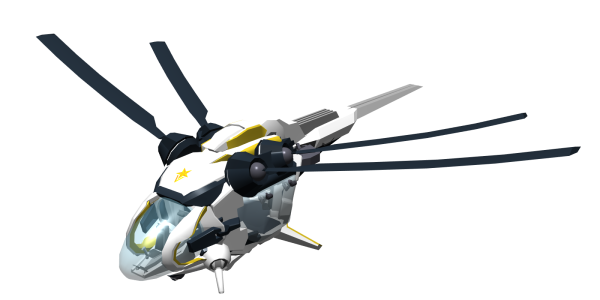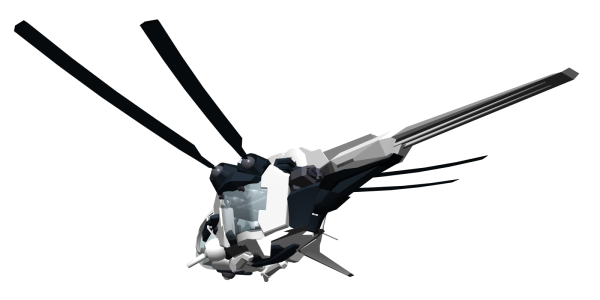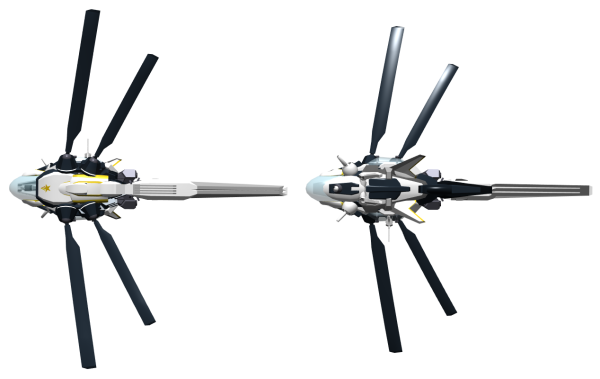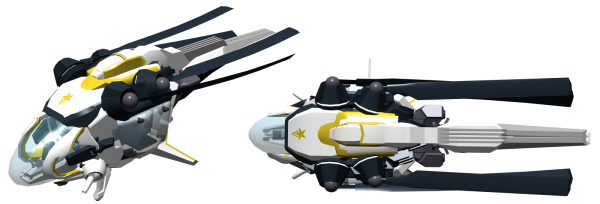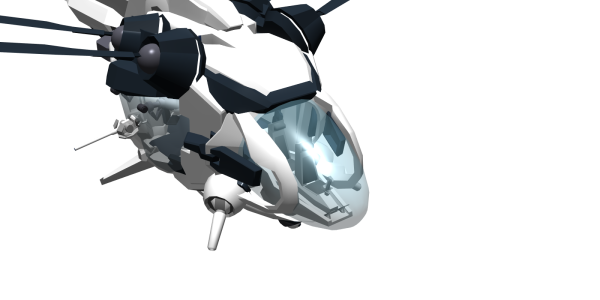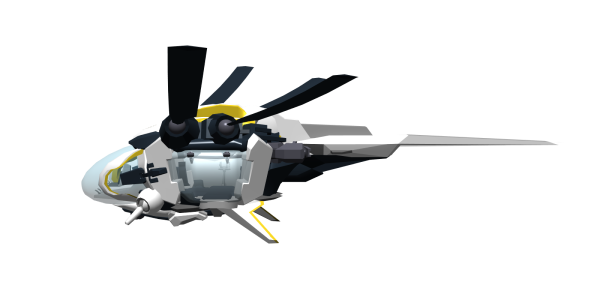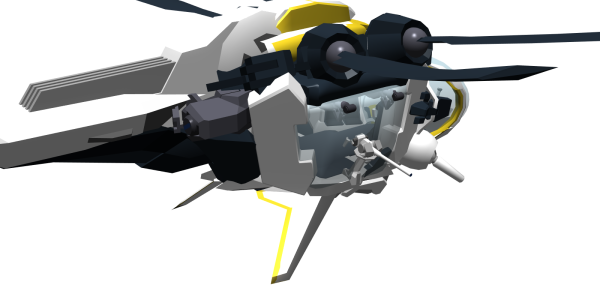Sidebar
Table of Contents
NH-T1 Dragonfly-class Shuttle
The Dragonfly is a swift, graceful shuttle craft made by Noval Heavy Industries.
Available for purchase starting in early YE 45
About the Dragonfly
Noval believes that local transport should be more than just convenient. It should be enjoyable.
Rather than focus solely on posh amenities, they instead sought to make the experience of traveling itself a joy. Taking inspiration from nature, the Dragonfly can swoop, soar, or hover in any direction. Subtle gravity tech allows the occupants to feel just the right amount of the motion to enjoy the experience without risking their drinks.
Optionally, the Dragonfly can be equipped with manned weapons on either side of its “open” passenger area to improve its combat capabilities. While the shuttle is not meant as a true combatant, Noval knows that there are times when extra security is appreciated.
Key Features
From a passenger perspective, the Dragonfly accomplishes the same goals as other shuttles. It can take them from one place to another in comfort and safety.
It is the design of the Dragonfly that sets it apart. The cockpit provides a nearly unobstructed view to the shuttle's pilot(s) to ensure that they perform at their best and have a good time doing so. The passenger compartment is comfortable, with open sides that are protected by the same shield technology as Noval's Chromatic Hangars, allowing them to watch the world go by without worrying about all that outside wind and noise.
The shuttle's smooth lines and bold design are best represented in its set of four long, dragonfly-like “wings”. Much like the insect that the craft takes its name from, these wings can fold, open, and work together to move the shuttle. Gravity manipulation technology assists the wings and allows the Dragonfly to move with or without atmosphere, as well as improving the overall performance of the shuttle.
Noval's attention to detail is present in the Dragonfly's interior. Seats are wide and comfortable, with drink chillers, ice machines, and more hidden within the walls. The default seat configuration allows all of the craft's passengers to face each other, as well as a central holographic display in the center. Other seat configurations are available that increase passenger capacity or provide a more traditional passenger experience.
The result is a craft that is impressively nimble and surprisingly comfortable.
History
While Noval has used existing, commercially available shuttles for years, they found themselves playing host to an increasing number of large corporations. For many of these guests, their first experience with Noval would be the shuttles they took to and from Noval's home station. After a while, it seemed odd that Noval wouldn't put its own best foot forward.
The early design process was simple. Noval often looks to nature for their product ideas and this was no different. Designers and engineers considered creatures from across the sector, selecting them based on their maneuverability and grace. Numerous birds and bird analogs were reviewed, as well as a variety of insects. The dragonfly was the one that captured their imaginations the most. It was not traditionally thought of as graceful, but there was something about the way it moved and the operations of its wings that felt right.
Getting the wings to work as intended proved to be a larger challenge than expected. Engineering the wings wasn't hard, nor was getting them to move, but there was an impressive amount of subtle movements that went into making a craft hover in various directions and travel at high speeds.
In some ways, nature provided its own answers. As drag increased on the shuttle's body with increased speed, the wings could be folded further and further back, until the shuttle relied entirely on its gravity drive systems. Small movements of the folded wings could still provide maneuverability. As the craft slowed, the wings could open more and more, until they were the major source of movement.
Using the wings in addition to traditional thrustless hover systems is something of an unnecessary extravagance, but the development crew had been part of Noval long enough to know that “unnecessarily extravagant” is essentially the corporation's hidden motto.
Appearance
The main body of the Dragonfly is ovoid. The front portion of the body is clear, with arched supports on either side. Inside the clear section sits the cockpit, where two pilots can operate the craft in tandem seating.
The rest of the body is largely passenger space, with open sides protected by a just-visible sheen of energy. Retractable landing legs are found towards the front of this area, while small wings sit towards the back on either side. These wings are strong enough to double as landing struts when the craft is not in flight.
Towards the top of the body is the majority of the Dragonfly's engines, power systems, and its four long, thin wings. Each of the wings is attached to a ball-and-socket joint, allowing them to smoothly move in many directions. When not in use, the wings fold back and tuck near the body. Otherwise, they fan out to the sides in true dragonfly fashion, thrumming up and down in such fast succession that they are barely visible at all.
A long tail extends out of the rear of the main body. It is thin and somewhat angular. When the Dragonfly lands, it partially retracts until it matches the length of the folded wings. When in flight, it extends to improve its control surface.
Statistical Information
The Dragonfly-class Shuttle is meant to get a small amount of elite passengers from one location to the next in style and comfort.
- Organization: Any
- Type: Shuttle Craft
- Class: NH-T1
- Designer: Noval Heavy Industries
- Manufacturer: Noval Heavy Industries
- Production: Mass
- Price: 25,000 KS
- Crew: 2 Recommended, 1 Minimum
- Passenger Capacity: 14 Maximum (in row seating configuration) 6 Maximum (in standard, conference-style seating configuration)
- Width: 15 meters (In flight, wings out), 3 meters (Landed/Transporting)
- Height: 12 meters (In flight), 10 meters (Landed/Transporting)
Speeds
During subsonic travel, the Dragonfly-class' wings handle most of the craft's movement. As it increases speed, the wings give way to the gravity drive systems and the shield strength increases to reduce friction, ensuring a smooth ride.
- Air speed: Supersonic (Maximum 3,000 km/h)
- Sublight speed: .375c
- Range: Limited by crew/passenger supplies, likely no more than two weeks for a normal crew/passenger arrangement
- Lifespan: 20 years
Damage Capacity Stats
See Damage Rating (Version 3) for an explanation of the damage system.
DRv3 Tier: 7
Interior
The interior of the Dragonfly appears simple and purpose-driven on first glance. It has few distracting features and is mostly made of smooth white surfaces and off-black floors. Handlebars are present along the ceiling to aid in moving around.
Closer inspection reveals careful details and hidden compartments. The smooth surfaces have a fine texture to them that makes them safer to rest against. Little details of inset wood and metal catch the eye without being distracting. Subtle labels, easy enough to spot when someone is looking for them, but not so loud as to make the walls look busy, indicate compartments that hold drinks, safety equipment, and passenger storage.
Cockpit
The Dragonfly's cockpit is a simple affair, with tandem seats for the pilots. All sides of the cockpit are transparent, save for the support rings on either side.
The craft's HUD is projected in the air while the craft is in use. This same projection system cleverly makes the support rings 'disappear', giving the overall impression that the pilots are sitting in midair.
Controls are surprisingly simple, with a basic throttle and joystick configuration doing much of the work. Whichever pilot is not currently operating the craft can take manual control of the Dragonfly's weapons, but automatic operation is also available. All other commands are handled either via voice, by indicating intent via looking at the HUD, or by the shuttle's simple AI.
Passenger Cabin
Comfortable seats and subtle use of technology makes the passenger cabin a joy to ride in.
Passengers feel little of the Dragonfly's movements, especially when it seems that they are busy. When passengers are relaxing, the suppression effects are weakened, so that they can feel the craft move more crisply. In all cases, should the craft make an unexpected move or orient itself in a way that would be discomforting, the Dragonfly automatically adjusts its gravity and internal velocity dampeners to keep passengers comfortable.
Ice machines, wine coolers, and a central holographic display provide entertainment for the journey. Passengers can watch shows, teleconference, and collaborate by using the display individually or as a group. Directed audio systems ensure that passengers can hear what they want to without disrupting other passengers. Noise cancellers are also present to effectively isolate passengers from each other, should the need arise, allowing everyone to take calls or enjoy isolation, as they wish.
Weapons Systems
Two turrets are towards the front of the craft. While not in use, the chaingun within is concealed by a conical cover that serves to reduce maintenance needs on the weapon and make it appear more friendly to passengers. When in use, the cover splits open by centrifugal force to allow the weapon to fire unimpeded.
- 2x Hyper-Shift Rotary Chaingun (T7)
Weapon mounts are available, allowing passengers to equip up to two Power Armor scale weapons in a mounted fashion. (T6, Maximum)
Onboard Systems Descriptions
The Dragonfly uses a small hyperspace tap system to keep it operating indefinitely. Life support systems are robust and designed to support up to fifty passengers, well beyond the craft's stated maximum.
A simple, but sophisticated, computer system translates the pilot's controls into movement. In this way, despite the operation of the Dragonfly-class' wings, it is as simple to operate as any other shuttle.
Cargo Capacity
A standard amount of personal effects, such as luggage, can be transported on the Dragonfly for its default passenger capacity of six. These goods are loaded into the walls of the passenger cabin. Capacity becomes strained for larger amounts of passengers and under-seat storage is recommended.
Standard Equipment
The Dragonfly comes with built-in wine coolers, ice machines, volumetric displays, and more to ensure that passengers travel in comfort.
In the event of an emergency, two weeks worth of rations and water, 2 fire extinguishers, and a variety of survival tools and equipment can be found in the cockpit's emergency storage. Within the seat back of every chair is a collapsed environment bodysuit and air tanks.
Noval recommends that Dragonfly crew perform weekly checks of all safety equipment to ensure that it is functional when needed.
OOC Notes
Whisper created this article on 2023/01/22 20:54.
🚧 This article is a work-in-progress. Is it not currently approved.
| Products & Items Database | |
|---|---|
| Product Categories | small craft |
| Product Name | Dragonfly |
| Nomenclature | NH-T1 Dragonfly |
| Manufacturer | Noval Heavy Industries |
| Year Released | YE 45 |
| Price (KS) | 25 ,000.00 KS |
| DR v3 max | Tier 7 |
Page Tools
Terms of Service - Privacy Policy

